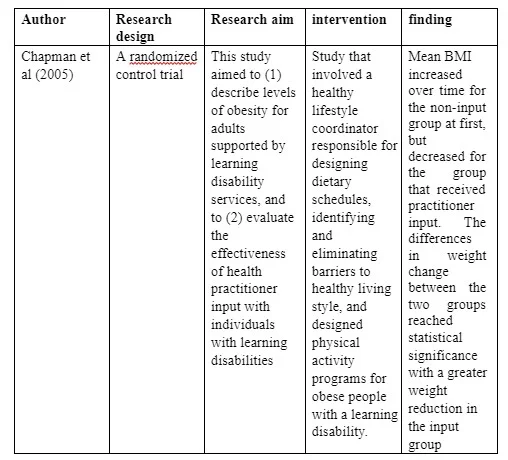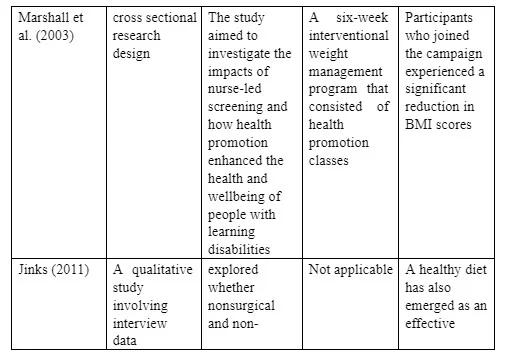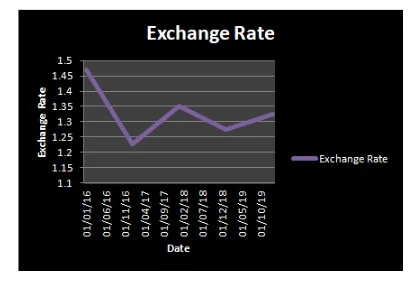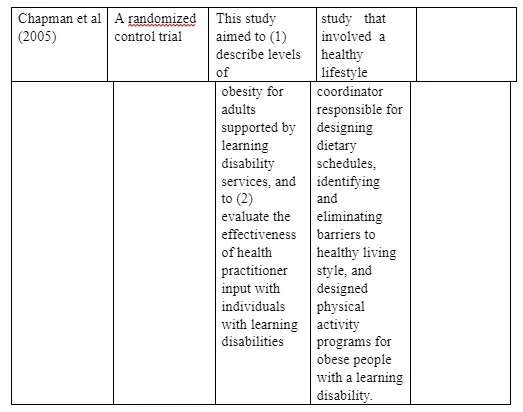A Comprehensive Overview of its Scope and Role
Introduction
Public health is a branch of medical science that deals with the protection of safety, and improvement of the health and wellbeing of communities through policymaking, education, research and disease prevention measures (Barber, 2017). Public health officers, therefore, deal with several health issues and monitor the community health status by evaluating any potential health problems that might affect the community, identifying and diagnosing community health hazards, and developing a partnership with other relevant health bodies to address health problems (Bray et al., 2016). Within their sphere of duties, public health officers deal with several health issues, one of them being obesity.

From time immemorial, obesity has been a significant issue of concern to public health officers primarily due to its increasing prevalence, and how it has affected people with learning disabilities (NICE, 2014). According to Biswas et al. (2018), the prevalence of obesity between the years 1993 to 2013 remarkably increased from 13.2% to 26% among men and from 16.4% to 23.4% among women within the same period. Notably, this increasing trend has been a concern to both the health sector and government authorities, considering its contribution to several other health issues such as cardiovascular disease, cancer, and diabetes (Biswas et al. 2018). Against his backdrop, various health authorities such as the National Health and Clinical Excellence (NICE) have emphasized evidence-based recommendations for developing effective intervention within primary care to reduce the prevalence of obesity among people with learning disabilities. For example, NICE (2014) developed guidelines aimed at addressing obesity especially in regards to the role of family carers and how they can support people with a learning disability in making lifestyle changes. Moreover, it is recommended that people with learning disabilities should be referred for appropriate services that involve an effective assessment of the underlying problems of obesity (NICE 2014).
Individuals with learning disabilities are more predisposed to obesity than the general population. Biswas et al. (2018) evaluated a report indicating that people with learning disability had a significant difference of obesity prevalence compared to those without learning disability, the former having a 28.3% prevalence while the latter having a 20.4% prevalence. In another study by Yamaki (2005) that evaluated a sample of 3499 non-institutionalised people with learning disabilities between the year 1997 and 2000, 34.6% of the participants were found to be obese. Similarly, Emerson (2005) conducted a study to evaluate the prevalence of obesity among people with mental disability under residential care and found that 27% of them were obese. In a more recent study, Bhaumik et al. (2008) found that individuals with a moderate learning disability had a higher prevalence of obesity compared to those with a more severe learning disability.
There are complex reasons for the high prevalence of obesity among people with learning disabilities. In this regard, Emerson & Hatton (2014) argues that an attempt to evaluate these reasons must consider the likeliness that obese people face different exposures to social determinants of health, and these may play a role in the difference. However, Butland et al. (2016) and Department of Health (2011) argue that some of the contributing factors to the difference in obesity prevalence among people with a learning disability and the general include poor nutrition, poor biological, psychological and social pathways, as well as poor neighbourhoods. Furthermore, Fenton (2017) blame other factors such as discrimination, social exclusion, stigmatization and poor socio-economic status as contributors to a higher prevalence of obesity among people with learning disabilities compared to the general population.
Moreover, people with learning disabilities face several other challenges such as inability to effectively communicate, poorly adjusted mainstream care services to meet their needs, and inadequate routine support from caregivers (Gilllam et al., 2012). More worryingly, there are studies (e.g., West Midlands NHS Trust, 2011) that have found a lack of confidence among health care providers in providing care to people with learning disabilities, especially in regards to acquiring and maintaining a healthy weight.
Being victims of such cumulated adversaries predisposes obese people with learning disabilities to more risk of poor health and wellbeing. Nonetheless, while some resultant conditions such as congenital health problems may not be curable, all the other effects of obesity among obese people with learning disability can either be cured, managed or prevented (Krahn & Fox 2014). Thus, the main aim of this study is to conduct a literature review of the various existing evidence-based treatment and management interventions for obesity in people with learning disabilities. After this introduction and background, there will be an illustration of the research methodologies and techniques employed by the researcher to successful achieve the research aim. After that, the researcher will present and discuss the results of the literature review before making concluding remarks.
Research Methodology
Search Strategy
The researcher conducted a systematic search and analysis of literature in a process that involved the gathering of relevant literary materials from online databases and evaluating the data to achieve the research aim. The systematic approach for identifying and assessing suitable literature materials was adopted to enhance the study’s duplication and transparency (Derish & Annesley, 2011). Besides, based on the assumptions by Pautasso (2013), the researcher intended to have more insight into the research topic by systematically identifying and evaluating pieces of literature data.
For sufficient identification and retrieval of data, the researcher relied on online databases and search engines – particularly, CINAHL, MEDLINE, EBSCO, and PUBMED. Grant & Booth (2009) confirms that online databases and search engines make it easier for the researcher to retrieve secondary data compared to a manual search of literature material from a physical library. Besides, according to Derish & Annesley (2011), online databases have a large number of secondary data on health and social sciences, thus justifying the researcher’s choice to use them. Nonetheless, retrieval of literary data from online databases is a procedural exercise that ultimately makes the study easily replicable.
Search Terms
The researcher relied on several search terms to conduct a comprehensive search of the literature. Some of them include Obesity, disability, learning disability, population, cancer, prevalence, intervention, and intellectual disability. The researcher customized the search strategy of effective retrieval of literary materials from each database using the Medical Subjects Headings (MeSH) and the search terms. In doing so, the search terms were linked with pre-determined research topics within each database. Nevertheless, the researcher also conducted a manual search from Google Scholar using the search terms to ensure that all the relevant research articles were retrieved.
Boolean Operators
The researcher manipulated the search terms using the Boolean operators (i.e., AND and OR) to enhance the precision and specificity of the search process. AND was used to broaden the search by combining several unrelated words e.g., Obesity AND Leaning disability, while OR was used to combine related words e.g., intellectual disability OR learning disability to narrow the search (Pautasso, 2013).
Inclusion and Exclusion Criteria
The researcher developed specific inclusion/exclusion criteria to establish the relevance and scope of literary materials retrieved for review. For instance, the study was limited to literary articles written in the English language to ensure that the researcher could easily interpret the data. Next, only studies that were retrievable in full text were included for review, so that the researcher could conduct a comprehensive review of the presented data. Lastly, the researcher relied only on academic papers to ensure that quality evidence-base was unveiled.
Data Extraction
The researcher independently extracted data from each article and collected all the relevant information for a clear presentation of the research findings. The researcher was mainly interested in: the author name of each publication, year of release, country of origin, the objective of the study, study methodology, study findings, and conclusions. Ultimately, the search process yielded seven studies for the final review. A summary of the study details have been highlighted in appendix 1.
Critical Appraisal
Critical appraisal of literature is an integral part of any literature review because it evaluates the quality of any research evidence that may be of interest to the researcher (Grant & Booth, 2009).
Besides, Derish & Annesley (2011) claims that critical appraisal of literature enables the researcher to establish the relevance of the presented evidence to the objectives of the current study. Typically, the critical appraisal process entails an evaluation of the strengths and weaknesses of the literary materials and confirming the validity of the data in respect to their ability to answer the current research questions (Derish & Annesley, 2011). As commonly practiced in health and social science researcher, the current study used the Critical Appraisal Skills Program (CASP) to evaluate the quality, relevance, and credibility of the selected literary materials.
The study adopted a thematic analysis approach to identify and analyse relevant data on effective interventions for obesity among the mentally challenged. Derish & Annesley (2011) define thematic analysis as a data analysis technique that is used in identifying, examining and recording patterns of data that make meaning and are relevant to the current research question in any given research. It entails the identification of patterns of information that provide a shared meaning across various data items, thereby enabling the researcher to find answers to the underlying research question (Cronin et al., 2008). Therefore, the researcher relied on thematic analysis to develop summaries of evidence on the effective intervention for obesity among people with intellectual disability. The review yielded two major themes namely: multidisciplinary approach and best interest decisions that adheres to the law.
Results
A keen review of literature on existing studies indicate a methodologically weak body of research on obesity interventions for people with learning disability, most of them involving a small sample population while others were not having controls (Hamilton and colleagues, 2007). Similarly, a comprehensive literature search revealed a lack of research evidence on surgical or pharmaceutical management interventions for obesity among people with learning disabilities. Notably, though, guidelines produced by the British Association of Psychopharmacology (BAP guidelines, 2016) weight when obese people with learning disabilities are under antipsychotic, and psychosis drug treatments, weight management programs for them should be overseen by highly skilled professionals with proper skills and knowledge in managing individuals with learning disabilities.
Multidisciplinary Approach
Nonetheless, Chapman and colleagues (2005) conducted a study that involved a healthy lifestyle coordinator responsible for designing dietary schedules, identifying and eliminating barriers to healthy living style, and designed physical activity programs for obese people with a learning disability. Other responsibilities of the coordinator were to coordinate with the patient, their families, the General practitioner, and support staff while. After a six-year follow-up, the intervention group was found to have had a general decrease in BMI over time, while the control group was found to have experienced an increase in BMI over time. However, the researchers reported an insignificant difference between the two groups, a phenomenon that can be attributable to small sample size (i.e., n=40 and n=33). Besides, being a multifaceted intervention, the researchers were unable to establish which part of it worked well and which category of people with a learning disability were the interventions most appropriate for.
Marshall et al. (2003) also conducted a study to investigate the impacts of nurse-led screening and how health promotion enhanced the health and wellbeing of people with learning disabilities. The study setting was in a clinic managed by two nurses, and which received patients from age ten for various health and social care services. The campaign involved screening, and after that, individuals found to be overweight were invited for a six-week interventional weight management program that consisted of health promotion classes. Follow-up results indicated that participants who joined the campaign experienced a significant reduction in BMI scores, triggering a conclusion that pro-active interventions for weight management are effective in addressing obesity among people with learning disabilities.
A healthy diet has also emerged as an effective intervention for the management of obesity among people with learning disabilities. In a small study, Jinks (2011) explored whether nonsurgical and non-pharmaceutical interventions could effectively help in managing obesity among this group of population. Ultimately, Jinks (2011) concluded that their nurses have a crucial role in working with obese people with learning disabilities to help them address their overweight issues and that further research is needed on how to address the perception of this group of people together with their families towards obesity. Besides, the researcher recommended new research on the cost and effectiveness of various interventions for obesity among people with learning disabilities.
Several pieces of research have focused on the design of services aimed at addressing obesity among people with learning disabilities. For instance, Beeken (2015) conducted a pilot study on a manualized weight management program for people with mild and moderate learning disabilities. The pilot study was controlled and randomized among (n=50) adults and compared patients under usual care to those under the manualized program. Ideally, the program involved 12-week group sessions facilitated with trained professionals who delivered a seminar on behavioural change techniques, physical activity, and healthy diet. At three months after follow-up, the researchers found that the program participants experienced a 0.34kgs reduction on weight compared to the group that received the usual care. Furthermore, follow-up after six more months revealed that the program participants had experienced an additional loss of weight of
00.55 kg.
In another study by Flanagan (2013), the researcher aimed to explore whether an effectively designed expert-led program for weight management could effectively help in managing overweight and obesity among people with learning disabilities. The researchers recruited a total of 74 adults with a BMI of more than 30kgs in the (MOTIVATE) program whose components were the application of various behavioural techniques, the development of physical activity and eating habits, and strategies of maintaining these habits. The program was facilitated by trained professionals and ran twice a week, for six months. After attending the sessions with their caregivers, follow-up studies revealed a 4% weight loss among participants within six months, and 50% of participants lost at least 5 kg of weight. Furthermore, the BMI of each participant reduced by an average of 1.73%, and the participants maintained a weight loss of 3% six months after the MOTIVATION program.
The reviewed literature highlight the critical nature of an interdisciplinary approach towards obesity among people with learning disabilities, This may entail cooperation between primary and secondary care practitioners such as a dietician, GP, the practice nurse, language therapist, as well as psychiatrist who give tailor-made obesity management services for people with learning disabilities. Ideally, developing a well-coordinated program aimed at delivering a proper dietary program titrated to the victim’s food preferences, a person-centred physical fitness program that takes into account the various health risks (e.g. Down’s syndrome or atlantoaxial instability) faced by this group of population, and an effective health promotion/education within the victim’s residential care or at the comfort of their home is vital for this group of population. Besides, leaning disability nurses need to establish a consistently coordinated approach between different staff teams towards several interventions aimed at establishing a structural and predictable plan of intervention. Consistency and predictability is especially vital for various learning disability complications such as autism.

Best Interest Decisions and Adherence to the Law
Ultimately, in another study by Rubbert et al. (2014) the researchers conducted a campaign on body awareness among a group of obese people with learning disabilities. The campaign was focused on the emotional and behavioural aspects of weight loss activities. The nine-week campaign included 2-hour sessions held once a week and was attended by overweight people with learning disabilities who were unhappy with their obese status. Particularly, the sessions involved discussions aimed at helping the participants understand how to address issues regarding how they felt about their overweight situation, their diet choices and why they found it hard to eat healthy food and their physical or emotional signs of hunger. Ultimately, Rubbert et al. (2014) found that the participants found it hard to resist food cravings despite having adequate knowledge on healthy eating, and generally had a negative perception about them for being obese. The researchers, therefore, suggested that weight loss programs for people with learning disabilities should be aimed at helping them understand the emotional and social factors affecting their dietary habits, as well as how to address their body image and self-esteem.
From the above evidence, it is clear that some obese people with learning disabilities may be non-cooperative or non-compliant to effective interventions for obesity. For instance, Rubbert et al. (2014) acknowledge that some of them do not like attending various clinical procedures such as surgeries, have a needle phobia, and may resist important clinical procedures such as diabetes screening. Such resistance may result in the development of un-detected health complications that may further escalate into health inequalities among them. Consequently, there is a dire need for learning disability nurses with appropriate skills to be involved in effectively managing obesity among this particular group through early detection of risks by conducting basic health screenings for BMI, blood pressure, specious girth measurements, and blood sugar levels. Furthermore, nurses should develop practical skills for carrying out the necessary screening at the patient’s home or within any comfortable environment where the patient is more likely to cooperate. In doing so, the Disability Rights Commission (2006) recommend that nurses should provide equal treatment to this particular group by conducting regular checks on them for early detection of any healthcare needs, especially those related to diabetes and cardiovascular diseases.
Service Improvement
Based on the above-mentioned pieces of research evidence, this study recommends improvement in the service delivery to obese people with learning disability by strictly adhering to the different stages of care pathways. According to Pheasant & Enock (2008), a proper adherence to care pathways, which entails identification of overweight, diagnosis, and classification of overweight, provision of first line advice regarding physical activity and diet behaviour, monitoring and follow-up, second line coordinated advise by a visitor nurse and a fourth line of diet advice by a professional dietician can enhance a quicker recovery from obesity and overweight among people with learning disability.
Thus, this study has established the vital role of early detection of obesity and frequent monitoring of this special group by learning disability nurse and general practitioners. and the need to adopt a generally inter-professional approach to the management of obesity among people with learning disabilities. Therefore, an essential practice point highlighted herein is the implementation of effective interventions aimed at reducing the risk of cardiovascular disease resulting from obesity and compounded by multiple factors such as non-compliance. Another critical practice point highlighted in this study is the essential nature of interdisciplinary working in developing effective interventions for the management of obesity among people with a learning disability. In doing so, all the relevant stakeholders, including the learning disability nurse, psychiatrist, language therapist, and dieticians, are expected to collaborate in providing quality care to this particular group. Finally, this study emphasizes four critical approaches to obesity among people with learning disability namely: proper dietary intake, physical activity, health education, and promotion, and a multifaceted approach that incorporates one or all the above aspects.
References
- Beeken R.J., (2015) Piloting a manualised weight management programme for overweight and obese persons with mild-moderate learning disabilities: Results of the Shape Up-LD study. Obesity Facts, May 2015, vol./is. 8/(189), 1662-4025.
- Biswas et al (2018). Obesity in people with intellectual disabilities and management of overweight and obesity in children, young people and adults [CG189].
- Bray G A, Fruhbeck G, Ryan D H & Wilding J P H (2016), Management of obesity. The Lancet. Vol. 387(10031) Pg 1947-1956. Available at: https://www.sciencedirect.com/science/article/pii/S0140673616002713
- Barber, S (2017), Obesity: A public health crisis? [Online] Available https://commonslibrary.parliament.uk/key-issues/obesity-a-public-health-crisis/ Accessed 27/5/2019
- Butland B, Jebb S, Kopelman P, McPherson K, Thomas S, Mardell J & Parry V (2007), Tackling Obesities: Future Choices-Project report. [Online] [Accessed 27/5/2019] available from: https://www.gov.uk/government/uploads/system/uploads/attachment_data/file/287937/07-1184xtackling-obesities-future-choices-report.pdf.
- Bhaumik S, Watson JM, Thorp CF, Tyrer F, McGrother CW (2008) Body mass index in adults with intellectual disability: distribution, associations and service implications: a population-based prevalence study. J Intellect Disabil Res; 52:287-98.
- Cronin P, Ryan F, Coughlan M. (2008) Undertaking a literature review: a step-by-step approach. Br J Nurs; 17:38–43.
- Chapman J, Craven J, Chadwick D. (2005) Fighting fit? An evaluation of health practitioner input to improve healthy living and reduce obesity for adults with learning disabilities. J Intellect Disabil; 9(2):131-44.
- Disability Rights Commission (2006). Equal treatment closing the gaps.
- Department of Health (2011), Start Active, Stay Active; A report on physical activity for health from the four countries’ Chief Medical Officers [Online] Available from: https://assets.publishing.service.gov.uk/government/uploads/system/uploads/attachment_data/file /216370/dh_128210.pdf Accessed 27/05/19
- Djalalinia S, Qorbani M, Peykari N & Kelishadi R (2015), Health impacts of Obesity; Pakistani journal of Medical Sciences. Vol.31 (1) pp239-242 Available at: https://www.ncbi.nlm.nih.gov/pmc/articles/PMC4386197/
- Derish, A. Annesley M. (2011) How to write a rave review. Clin Chem ;57:388–391.
- Emerson E., & Hatton C. (2014). Health inequalities and people with intellectual disabilities. New York: Cambridge University Press
- Fenton, K (2017), Health Matters: Obesity and the food environment [Online] Available from: https://publichealthmatters.blog.gov.uk/2017/03/31/health-matters-obesity-and-the-foodenvironment/ Accessed 27/05/19
- Flanagan C. (2013) Motivate: A structured behavioural weight management program for obese adults with Learning Disabilities. Obesity Facts, May 2013, vol./is. 6/(117), 1662-4025.
- Gadde K M, Martin C K, Berthoud H & Heymsfield S B (2017), Obesity: Pathophysiology and Management. Journal of the American College of Cardiology Vol.71 (1) pg69-84. Available from: https://www.sciencedirect.com/science/article/pii/S0735109717415841
- Gillam S, Yates J & Badrinath P (2012) Essential Public Health; Theory and Practice. 2nd Ed. Cambridge University Press, Cambridge.
- Grant J, & Booth A. (2009) A typology of reviews: an analysis of 14 review types and associated methodologies. Health Info Libr J;26:91–108.
- Jinks, (2011) Obesity interventions for people with a learning disability: an integrative literature review. Journal of Advanced Nursing, 2011, vol./is. 67/3(460-471), 03092402.
- Krahn G. L., & Fox M. H. (2014). Health disparities of adults with intellectual disabilities: What do we know? What do we do? Journal of Applied Research in Intellectual Disabilities, 27, 431– 446.
- Marshall D., McConkey R. & Moore G. (2003) Obesity in people with intellectual disabilities: the impact of nurse-led health screenings and health promotion activities. Journal of Advanced Nursing 41(2): 147-153.
- Pheasant H. & Enock K. (2008) Developing children’s obesity care pathway(s) – A ‘How To’ Guide, Public Health Action Support Team, London Child Obesity Care Pathway Working Group, London.
- Pautasso M. (2013) Ten simple rules for writing a literature review. PLoS Comput Biol;9:e1003149.
- Rubbert (2014) Establishing a body awareness group for adults with learning disabilities. British Journal of Learning Disabilities, vol./is. 42/1(43-49), 13544187.
- Yamaki K (2005) Body weight status among adults with intellectual disability in the community. Ment Retard; 43(1):1-10.
Appendix 1: Study Details




Continue your journey with our comprehensive guide to A Comprehensive Literature Review.
- 24/7 Customer Support
- 100% Customer Satisfaction
- No Privacy Violation
- Quick Services
- Subject Experts



